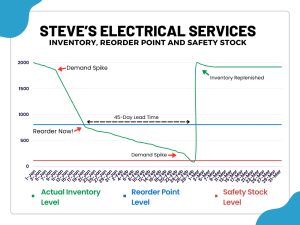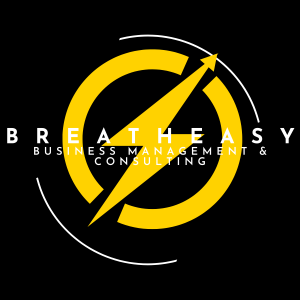Radio Program, Run to Win
Join us on Dec. 27th at 4 PM ET on Run To Win’s weekday radio program, where KrisAnne will have a conversation with Janice Daniels, former Mayor of Troy. Don’t miss this engaging discussion!
Join us on Dec. 27th at 4 PM ET on Run To Win’s weekday radio program, where KrisAnne will have a conversation with Janice Daniels, former Mayor of Troy. Don’t miss this engaging discussion!

The Big Picture
Keeping track of inventory might sound pretty boring, but trust me, it’s more important than you think. This is especially important for retailers. Good inventory management is about striking a balance—enough stock to keep your customers happy but not so much that all your cash is tied up and you’re drowning in unsold goods with no cash to pay the water bill.
You see, for those of us who aren’t aware, inventory is basically cash, but locked in a lockbox that can only be opened with the sale of a product. So, if you are deciding to lock up your cash in the form of inventory sitting on shelves, you better have a very solid understanding of when that lockbox will release its green treasure inside. Otherwise, you’re locking up that value for no good reason. Trust me when I tell you that uncontrolled inventory levels will kill a business.
In a recent engagement with a small retail store client, managing their inventory was a major issue. They simply didn’t understand:
Yes, they understood as a general concept that managing inventory was important, but they didn’t fully appreciate how its mismanagement had downstream affects (until those affects hit like a Florida hurricane). Their understanding of ‘inventory management’ only extended to understanding the need to have inventory on the shelves for customers to buy in the moment. It did not extend to understanding the downstream effects of inefficient inventory levels.
And this brings us to the first topic in a series of three essays over the coming weeks about inventory management: Reorder Point.
Reorder Point answers the fundamental question,
When Do I Reorder?

You Think You Can Eyeball This?
For that small retail establishment, not understanding inventory management was, by far, their biggest problem. If you don’t know why doing a thing is important, you’ll never bother learning how to do it properly.
To fix this issue, I started by changing their thinking: I told them that they weren’t in the widget-selling business; they were in the inventory management business. No matter what their store was selling, they must always ensure their inventory levels were optimized. This new way of thinking means that we all must be experts in managing our inventories.
And what does that mean? It means efficiently managing inventory across three components:
We’ll be discussing these three aspects to inventory management over the coming weeks, but this week, we’re talking about Reorder Point.
The reorder point (RP) is the level of inventory that, when your inventory levels drop to that count, you place a new order. It helps you restock before running out, keeping customers happy and cash flow in check.

The Big Picture
First things first, you need to know how much you sell each day. Don’t guess; use your sales data. Look at a month or two, count how many units you sold, and divide by the number of days. For example, if you sold 300 units in 30 days, that’s 10 units per day. Easy math, right? And don’t be afraid of fractions of a unit. We’re doing math to calculate averages here so fractions are permissible.
Next, figure out your lead time. That’s a fancy way of saying,
“How long does it take for the stuff I ordered to show up at my door?”
If your supplier typically takes 7 days to deliver, then that’s your lead time. Just make sure you’re not counting on that one magical day when everything showed up in 24 hours! We’re looking for typical, average lead times.
We’re going to talk about Safety Stock, what it is and how to calculate it, next week. But for now, just understand that this is your emergency stash. It’s that extra roll of toilet paper you hide in the back of the closet. Safety stock is there to protect you against the unexpected—like if demand suddenly spikes or your supplier goes on vacation. If you’re selling consistently, you might not need much. If your sales are all over the place, stock up a bit more. As I said, we’ll discuss how to calculate Safety Stock next week.
Now, here’s where the magic happens. The formula for RP is simple:
Reorder Point = (Average Daily Demand × Lead Time) + Safety Stock.
For example, if you sell an average of 10 units a day, your lead time is 7 days, and you keep 20 units as safety stock, your reorder point is
(10 × 7) + 20 = 90 units.
In practice, what this means is that when your inventory level drops to 90 units, you start calling your vendor to place an order. And yes, it truly is that simple.
Now, contrast this to the bad old days of inventory management by just walking around and eyeballing your inventory. You’d look at your shelves, notice that you’re a little low on some widget or doohickey and you put in an order to replenish. Who knows if you actually needed that doohickey. But it looked low so you put in an order, tying up yet more cash into that lockbox.
When you set data-driven reorder points, you’re taking control. No more guessing games. You’ll know exactly when it’s time to reorder, keeping your shelves stocked and your customers smiling.
But there’s a catch! This absolutely presumes that you have the data (or can estimate it) to run these calculations. This means then that, if you want to take your inventory management to the next level and move beyond merely eyeballing and unnecessarily locking up cash, you need to keep track of the relevant variables. This is yet another reason to keep good records and manage your business with data and not hunches.
So there you have it: Reorder Point. It is the inventory count that, when your inventory levels drop to this number, it is time to reorder. It takes an objective, mathematical and data-driven approach to managing your inventory that takes the guess work out of things and guarantees an efficient use of your limited funds.
 If you’re thinking that you’d like some assistance in getting your inventories organized and optimized, or if you’re thinking that your business in general is not running as efficiently as you believe it could be, please schedule a zoom call to discuss what’s on your mind. I am 100% confident that whatever issue or pain point you are facing, I have seen it before and have a solution ready – made for you.
If you’re thinking that you’d like some assistance in getting your inventories organized and optimized, or if you’re thinking that your business in general is not running as efficiently as you believe it could be, please schedule a zoom call to discuss what’s on your mind. I am 100% confident that whatever issue or pain point you are facing, I have seen it before and have a solution ready – made for you.
So please, don’t hesitate to reach out. I offer a free 1-hr consult to discuss your issues and create a plan to tackle it.
 The 5D Business Check Up measures your business across the 5 major dimensions common to every business:
The 5D Business Check Up measures your business across the 5 major dimensions common to every business:
Sales & Marketing
Finance & Accounting
Operations
Inventory Management
Strategy & Planning
The 5D Business Check up starts with over 40 questions that delves into your personal observations as well as objective measurements taken directly from your financial statements. Once your questionnaire is complete, you will recieve a formal report assessing the strengths and weaknesses of your business with recommendations to improve.
Purchase the 5D Business Check Up here

Learn the skills and get the knowledge you need to start, operate and manage your business efficiently with The Tradesman’s MBA. You can learn more about this great resource for the entreprenuer here.
 In the world of small business, a business model is like the architectural blueprint of a building. It lays out how a company intends to operate, generate revenue, and sustain itself in the long run. A well-defined business model is important because it helps entrepreneurs understand their market, allocate resources efficiently, and communicate their value proposition to stakeholders.
In the world of small business, a business model is like the architectural blueprint of a building. It lays out how a company intends to operate, generate revenue, and sustain itself in the long run. A well-defined business model is important because it helps entrepreneurs understand their market, allocate resources efficiently, and communicate their value proposition to stakeholders.
Just like a chef needs a recipe to prepare a dish, a business owner needs a business model to steer their company towards success.
To build a successful business, you should begin by understanding the key components of a business model. These elements collectively define how a business creates, delivers, and captures value.
Here’s a breakdown of each component:
As you are contemplating documenting these different components of your business model, it might help you to think of each of these sections as a puzzle piece that slots together with other pieces of your business.
Many within the business world use the terms business plan and business model interchangeably. Just know that when you see this happen (and you will), know that these poor souls have very little understanding of either of these terms, which puts you at an advantage!
What these folks don’t understand or were never taught was that these two terms/documents serve very distinct purposes within a company’s strategy.
A business model is a conceptual framework that outlines how a business creates, delivers, and captures value. It focuses on the components that make the business work, such as the value proposition, customer segments, revenue streams, and cost structure.
On the other hand, a business plan is a detailed document that describes the company’s goals, strategies, market analysis, and financial projections. It acts as a roadmap for the business, guiding its operations and growth over time.
When you are contemplating starting a business and making decisions about your business plan, understand that a business plan typically includes the business model as one of its components! If you’d like to learn more about Business Models, I highly recommend the book “Business Model Generation.” This book is on my personal book shelf and I use it often as reference and inspiration. I receive no kick backs on this recommendation, it’s just a good reference.
Subscription Model:
In the subscription model, customers pay a recurring fee to access a product or service. This model is popular in the software and entertainment industries, such as Netflix or Adobe Creative Cloud. Subscription models provide businesses with a predictable revenue stream and foster customer loyalty.
Freemium Model:
The freemium model offers basic products or services for free while charging for premium features. Companies like Spotify and Dropbox use this model to attract a large user base and convert some of them into paying customers. This model relies on a clear upgrade path and compelling premium features to drive revenue.
E-commerce Model:
The e-commerce model involves selling products or services online. Businesses using this model, like Amazon or Etsy, can reach a global audience and operate without the overhead of physical stores. The e-commerce model focuses on efficient distribution channels and customer experience.
Franchise Model:
In the franchise model, a business owner (franchisee) buys the rights to operate a business under an established brand (franchisor). Fast-food chains like McDonald’s or retail stores like 7-Eleven use this model. Franchises benefit from brand recognition, established business practices, and ongoing support from the franchisor.
The Razor Blade Model:
This a business model that we discuss in The Tradesman’s MBA. It describes a company that offers a primary product at a low price or even at a loss (the “razor”) and then makes profits by selling complementary, high-margin consumable products or services (the “blades”). This model leverages the initial purchase of the primary product to lock in customers and drive continued sales of the consumables.If you’ve ever had to buy replacement ink for your printer, you’ve seen the ‘razor blade’ model in practice.
Here’s how to choose the best model for a given business type:
Clarity and Focus
Documenting the various components of a business model provides you clarity and focus. When you outline each element — such as the value proposition, customer segments, and key activities — you gain a better understanding of how each part of the business fits together and contributes to the overall strategy.
More important tha that, however, is that it also allows you to identify any gaps or inconsistencies in the business that may need to be addressed.
Strategic Decision-Making
Documenting how the different components of your business fit together (vendors, customers, distribution channels, etc.) provides you a comprehensive overview of the business’s operations. This is very similar to what we in the Six Sigma world call a Value Stream.
When you examine the different components of your business, you can make informed decisions about potential changes, such as targeting new customer segments, adjusting pricing models, or developing new products or services.
Communication and Alignment with Stakeholders
A documented business model serves as a valuable communication tool for engaging with stakeholders, such as investors, partners, and employees. It provides a clear and concise representation of how the business operates and generates value, making it easier to explain the business’s strategy and vision to others. This can be especially powerful when depicted as a graphic.
This transparency helps build trust and credibility with external stakeholders, such as investors, who need to understand the business model to assess the potential for success and profitability.
While not a hard and fast rule that every business must document their business model, I can tell you that when you include it as part of your Business Plan, point number 3 above becomes much more important and much more powerful.
To Your Success,
 If you’d like some assistance with laying the foundation of your business, please don’t hesitate to reach out for a free consult. Together, we can transform your idea into a well-documented plan of action which will give you the confidence to move forward with your idea and be ready to present to investors.
If you’d like some assistance with laying the foundation of your business, please don’t hesitate to reach out for a free consult. Together, we can transform your idea into a well-documented plan of action which will give you the confidence to move forward with your idea and be ready to present to investors.
 And in case you hadn’t heard, BreathEasy also has a book available. It’s called The Tradesman’s MBA. I wrote this book for the entreprenuer who has ideas for a new business, but lacks the business knowledge to make it successful. The book is jam packed across nearly 300 pages of every conceivable concept, explained in plain language for the new and existing business owner alike. It contains real world examples, thorough explanations and assumes NO KNOWLEDGE of business. This is written for the entrepreneur who knows he lacks information and is intent on filling that gap.
And in case you hadn’t heard, BreathEasy also has a book available. It’s called The Tradesman’s MBA. I wrote this book for the entreprenuer who has ideas for a new business, but lacks the business knowledge to make it successful. The book is jam packed across nearly 300 pages of every conceivable concept, explained in plain language for the new and existing business owner alike. It contains real world examples, thorough explanations and assumes NO KNOWLEDGE of business. This is written for the entrepreneur who knows he lacks information and is intent on filling that gap.
Topics include:
Good Luck!

Side Hustle or Business?
Last year, an older friend of mine dipped into his 401K to purchase a handy-man business with his son. The details of the sale and the state of the business itself when they bought it, I don’t know. But what I can tell you is that their handy-man business is absolutely booming. And I couldn’t be happier for him. My friend took a chance, gambled his retirement and, for all intents and purposes, appears to be winning. I honestly only rarely see him anymore because he is so busy, so full is his calendar with clients’ jobs.
You see, the problem is that my exhausted friend and his son simply can’t know how truly well their business is doing because they are ignoring the most important aspect of their business: cash flow. They see cash flowing into their bank account and see success. This is not correct.
 You see, my friend and his son didn’t buy a business with employees; he and his son are the employees. What this means is that because they have so much work to do, they don’t have time for much else. As soon as the purchase of the business closed, they have been running at a million miles an hour trying to keep up with the work they have booked! When last I spoke with him, he had jobs booked out at least a month and a half into the future. A very good problem to have. But because he and his son are the only employees, their business will never grow beyond what they can do. At a certain point, Queue Theory states that their future customers will cease waiting in line and hop to a competitor! Not good.
You see, my friend and his son didn’t buy a business with employees; he and his son are the employees. What this means is that because they have so much work to do, they don’t have time for much else. As soon as the purchase of the business closed, they have been running at a million miles an hour trying to keep up with the work they have booked! When last I spoke with him, he had jobs booked out at least a month and a half into the future. A very good problem to have. But because he and his son are the only employees, their business will never grow beyond what they can do. At a certain point, Queue Theory states that their future customers will cease waiting in line and hop to a competitor! Not good.
What my friend and his son don’t see yet is that, they may have bought an existing business but they aren’t operating it as a business; they are basically running a glorified lemonade stand. They are still trading time for money. What my friend doesn’t see just yet is that owning a business is more than just getting jobs and doing work. That’s what employees are for. The role of a business owner is much broader.
My friend and his son are ignoring:
Do you see what I am getting at? My friend, unfortunately, does not own a business. He owns a side – hustle that is masquerading as a business.
 One day my friend and I were chatting and he told me about a job that they had just finished. He proudly told me that it priced out to a tune of $15,000; a princely sum no matter who you are. I naturally congratulated him on booking such a high-priced job and asked, “How did the costs break out for that $15,000 dollar job?” I was obviously curious about the margin of such a high-priced job.
One day my friend and I were chatting and he told me about a job that they had just finished. He proudly told me that it priced out to a tune of $15,000; a princely sum no matter who you are. I naturally congratulated him on booking such a high-priced job and asked, “How did the costs break out for that $15,000 dollar job?” I was obviously curious about the margin of such a high-priced job.
At this point, he proudly told me that the cost of materials was $12,000 alone. Yes, that IS a big job! He continued, “we made $3,000 on that job alone over one weekend!”
It was at this point that I asked, “did you and your son work on the job?” To which he responded, yes. “And the job was a full two days’ worth of work?” Again, he answered yes.
Punching a couple buttons on my calculator, I paused, took a breath, and broke it to him saying: “Brother, I hate to break it to you, but you didn’t make any profit on that job.”
It was at this point a confused look on his face appeared.
I continued, “Let me explain. Assume your hourly rate is $85/hour. Let’s also assume that your son’s hourly rate is also $85/hour.”
“OK,” he responded cautiously.
“Well,” I continued, “that is a total of $170/hour for the two of you. And because you both worked 2 days (16 hours), that comes out to a total labor cost of $2,720. Did you include the cost of labor in your bid?”
It was at this point that my friend’s look of confusion slowly began to morph to a look of resistant realization.
I continued, “if your total labor cost was $2,720, and your total materials cost was $12,000, the job cost you a total of $14,720. Buddy, you didn’t make $3,000 on that job. You spent an entire weekend working in the hot Florida sun for 16 hours for a measly 280 bucks that you have to split between you and your son.”
I didn’t have the heart to ask him if he charged tax on the job which would have only exacerbated the loss.
Ouch.
As you can see, although my friend bought a business, he is operating it like a side-hustle; pretending to be a business owner, when in fact, he’s operating no differently than a kid with a lemonade stand or lawn mowing business.
His oversights may be obvious, but why do so many business owners like him ignore the business side of their endeavors? Why does this always happen?
My sense is that it’s a combination of factors, not least of which is Human Nature. You see, we tend to pay attention to the things that we understand and interest us and ignore those things that we don’t.
My friend is a technical wizard; he is not a handy man; he is a handy magician. He is so incredibly talented and experienced, there’s nothing this man can’t fix, build or replace. In fact, if someone were to ask me, I would recommend him in a second and give them his website to schedule work! If only he had one…
The reason he and his son are ignoring the business side is because they are not familiar with the skills necessary to properly manage it. They have the skills and experience to be employees, but not business owners. As a result, they naturally gravitate and pay attention to the aspects of their business that they DO understand. Quite natural.
But ignoring this part of their company doesn’t mean it will magically improve. Nor does it mean the IRS will happily ignore it either.
The ironic part is I can completely understand and sympathize with why my friend and his son ignore the more technical part of their business. Why should they? They are making money hand over fist and running from job to job to job. Their bank account is fat and they’re busy. How could they possibly be failing? Well, busy doesn’t equal profitable, as we just saw.
Do you think this could be happening to you as well? Do you think you might have blind spots that you’re not aware of?
Here are my recommendations for my friend’s business:
 These four steps would pay HUGE dividends in operational efficiency for his company. And efficiency, as a business owner, should be what you are aiming for. Not just ‘high priced’ jobs. How well are you managing your operations?
These four steps would pay HUGE dividends in operational efficiency for his company. And efficiency, as a business owner, should be what you are aiming for. Not just ‘high priced’ jobs. How well are you managing your operations?
I would also add one more strategic step: Hire two employees to take his, and his son’s, places executing the jobs so that he (the father) can manage the business from his home office and get out of that Florida heat and let his son collect and estimate jobs for clients. THAT would be the formula to grow his business beyond a glorified side-hustle.
So how can YOU avoid making the same mistake so many other small business owners just like my friend make?
This is the easiest fix in the world, and you have a choice. You can either:
 If you opt for the learning route, can I recommend The Tradesman’s MBA? It provides all the fundamental information a business owner needs to organize his business for efficient success. Topics include Finance, Accounting, Operations, Inventory Management and Strategy.
If you opt for the learning route, can I recommend The Tradesman’s MBA? It provides all the fundamental information a business owner needs to organize his business for efficient success. Topics include Finance, Accounting, Operations, Inventory Management and Strategy.
If, however, you’d prefer someone to come along side and guide you as you build or optimize your business, please consider reaching out for a free consultation. The services that BreathEasy Consulting can provide include, but are not limited to:
Sincerely,
Founder, BreathEasy Business Consulting and Bookkeepting

I think I might have noticed something, and I’d like to get your thoughts on it.
Have the Communists made a fatal strategic mistake in putting up Harris? And is President Trump silently allowing them to make it?
If I were a betting man, I’d bet that Napoleon was required reading at the New York Military Academy and young student, Donald, learned the lesson.
Never Interrupt an Enemy When He is Making a Mistake
I think we can state fairly unequivocally that there isn’t much that the President does not see or is unaware of.

If we go all the way back to 2011, while a guest of the Harpy-vision ‘chat show,’ The View, private citizen Donald Trump noted how there was a question about Barak Obama’s birth certificate:
Why doesn’t he show his birth certificate? There’s something on that birth certificate that he doesn’t like.
Knowing what we know now about how President Trump communicates, enters information into the national discussion, etc. might we look upon his statement at the time, and others similar to it, a little differently?
And, as history has borne out, Obama and his puppet master actually got away with the fraud of his birth certificate, even in spite of the mountains of evidence. Also, as Napoleon stated:
History is the version of past events that people have decided to agree upon
So, ok. Our enemies won that battle and were able to install a fraud, and keep him there, for 8 years; not counting his behind-the-throne time during the Biden/Harris ‘administration.’
But one thing that many of us have noticed over here in Sanity-land is that our enemies are completely and unequivocally lacking in any sort of imagination. They are wholly unable to update their playbooks as conditions on the ground shift under their feet.
Just look around and you’ll see it.

And that is just off the top of ChatGPT’s head.
The point here is that, collectively, we are on to their playbook. And not only is the Great Noticing happening in parallel with the Great Awakening, but we are no longer falling for, literally, any of it. The presumptions that the news informs, that our government is legitimate, that doctors heal and that taxes pay for infra structure are all irretrievably and irrevocably destroyed. And this is by their own hand, mind you, in their vainglorious attempt to hold onto power!
structure are all irretrievably and irrevocably destroyed. And this is by their own hand, mind you, in their vainglorious attempt to hold onto power!
Ain’t the Information Age grand?
Now, in their attempt to turn the presidency into the ultimate DEI position, they have now declared (without a nominating convention, mind you) that Kamala Harris will be their presidential nominee, who will go up against President Trump in November (if the election happens at all).
Now, from a power broker’s point of view, she couldn’t be a better choice! She will do exactly as she’s told. She will say exactly what she’s told to say and, bonus, she can walk up stairs without looking like a Benny Hill character.

Let’s not forget that in 2019, Kamala’s likeability among Democrats was so far in the toilet that she couldn’t make it past the first debate with the other D(emonic) candidates for the democrat nomination. She is universally despised. Is anyone else wondering how a cage match between that gruesome twosome, Harris and HRC would look?
Everyone is perfectly aware that Harris was not chosen to be Biden’s number 2 (VP, not the one in his diaper) specifically because of the color of her skin and what is (presumably) between her legs.
Americans are told that she is the first black VP but, unfortunately, the facts don’t bear this out. According to literally 2 seconds of research:
Both, her mother and her father gained their American citizenship in 1966. But Kamala was born in 1964. This makes Kamala officially ineligible for the presidency because she was born of citizens of a foreign country at the time of her birth.
Do you honestly think President Trump is unaware of this fact?
Let us return to Napoleon’s statement:
Never Interrupt an Enemy When He is Making a Mistake
You see, the D(emons) installed Harris into the office of the Vice President and got away with it. So why not go for the whole enchilada again (like BHO) and install her into the top slot? It obviously wasn’t an issue before, right?
But what the Democrats and their string pullers fail to realize is that the world is not a static thing, as much as they wish it to be. It has changed. They no longer own organs of public discourse like they once did. The Truth will out.

As evidence of this, just look at how the regime is trying to tell us that the attempted assassination of President Trump was by a lone gunman when information exists collected, analyzed and publicized by private citizens that there were at least 3 gunmen present. That certainly didn’t happen in 1963 when all we had was Mr. Zapruder!! The water tower is today’s latter day ‘grassy noll.’
Have you seen the analysis that has been put out there of the event? The level of sophistication available to private users is unprecedented and shines a light on the lie to the government’s preferred narrative. They simply can’t lie with impunity any longer.
Returning to the Kamala Question:
Have you noticed that President Trump is (uncharacteristically) silent on the point that she is demonstrably ineligible? His silence is the very definition of the dog that didn’t bark. We don’t need a fake birth certificate; it is widely known that Kamala is an anchor baby.
I’m going to go out on a limb and make a fun little prediction.

Kamala, Is That You?
I PREDICT that President Trump will wait until after Willy Brown’s sidepiece is officially nominated by the Democrats, allowing them to fully commit and enter into the lobster trap. Then, and only then, will he raise the issue. And by that time, what can they do? Shut off the internet? Oh, wait…
My point is that the sands have shifted under the Democrats’ feet and they refuse to change tactics from what has worked before when we, as a nation, were more naive, weaker and less informed about the reality of our world.
I suppose time will tell on whether what I am seeing will bear out into reality. So, with that little observation, I will leave you with another great quote from Napoleon:
There are only two forces in the world, the sword and the spirit. In the long run, the sword will always be conquered by the spirit.
Sincerely,
Founder, BreathEasy Business Consulting
 Building a business is hard. You need to get your mission right, then your marketing message, then your sales pitch, then your products, then your management and operations, and finally your cash flow management.
Building a business is hard. You need to get your mission right, then your marketing message, then your sales pitch, then your products, then your management and operations, and finally your cash flow management.
Very few small business owners understand how to operate the six necessary pillars of a strong business and that’s why most small businesses fail.
Schedule your discovery call today and let’s get started building the small business of your dreams.
To schedule your zoom call to discuss your pain points, simply click here.

Now understand: I refuse to call any of these folks ‘Far’ Left because they simply aren’t. Their poorly-informed/poorly-formed ideas are mainstream Leftist beliefs that have metastasized through their body politic like a genetically modified Chinese virus. Granted, these loons are radical and ‘far’ removed from reality or the standards of western civilization, but that’s a topic for another day. Read more
The BreathEasy App has fulfilled its purpose and is now discontinued.
![]() Yes, you read that right, the BreathEasy App is now officially retired. The conditions that forced its creation during COVID and the lockdowns have “passed” and the BreathEasy App is now collecting social security and taking it easy watching daytime TV.
Yes, you read that right, the BreathEasy App is now officially retired. The conditions that forced its creation during COVID and the lockdowns have “passed” and the BreathEasy App is now collecting social security and taking it easy watching daytime TV.
But if the BreathEasy App is being retired, does this mean that BreathEasy is shutting down?
Absolutely not!
BreathEasy is shifting its mission to directly support small business.
It is my opinion that our great nation is about to enter a period of rebuilding after the horrendous torture we all have suffered together over the last several years.
And if you’ve learned anything about me over the years, you know I am a huge supporter of small business. Helping small business is my sincere passion and there’s nobody I respect more than the entrepreneur who risks it all to strike out on his own. The BreathEasy app was purpose built to protect small business patriots from illegal mandates. That mission hasn’t changed.
Therefore, I’d like to announce that BreathEasy is rebranding to BreathEasy Business Consulting & Bookkeeping. The new mission of BreathEasy will be to support Small Business owners directly with key services that every small business owner needs.
We all agree that there is a massive shortage of skilled tradesman. The need is undeniable. And beyond this need is the need for these tradesmen to be successful.
It does our nation no good if we have skilled men and women rebuilding our nation if those same small business owners go bankrupt because they lack the skills they need that our education system failed to teach.
While BreathEasy will specialize in advising Trades businesses, the services provided are equally applicable no matter the industry. Business owners from any sector are welcome to join me.
As part of this pivot to directly support small business, I’d like to introduce the services BreathEasy now provides:
Business Consulting and Management
If this sounds like you, then please, go to www.breathez.org and schedule a free call. Together we’ll get your business or start – up humming like a well-oiled machine.
In addition to the specialized services offered above, BreathEasy has slots for 10 bookkeeping clients. Ask yourself:
If you need assistance in setting up your books, cleaning up your books or simply managing your books, BreathEasy provides expert bookkeeping services to keep you informed with the most up to date information about the health of your company. I’m only accepting 10 clients to ensure I can provide the level of expert care necessary, so don’t delay!
And, finally, the reason why you haven’t seen many essays from me lately and the absolutely shameless plug:
Over the last several months, I have been diligently working on a textbook that teaches the concepts and skills necessary to succeed in small business. I call it The Tradesman’s MBA and is available for pre-order now and is expected to be available July 15th.

The Tradesman’s MBA has two target audiences:
In both cases, The Tradesman’s MBA teaches numerous business concepts and skills taught in America’s business schools to help you succeed.
We are Americans! Shouldn’t the skills necessary to start and operate a small business be required knowledge?
The Tradesman’s MBA gives you the comprehensive knowledge and skills you need to set the firmest foundation possible for your business to ensure success.
The Tradesman’s MBA leads you step by step and distills down all the key information taught in today’s business schools so that you are equipped to tackle any business question. If you’ve ever had questions about the following topics, this guide is for you:
I wrote The Tradesman’s MBA to help small business and entreprenuers to succeed by teaching them the skills and techniques they need to avoid the traps and tribulations that so many others (including me!) have suffered.
Friends, if you happen to know of a small business owner or entrepreneur that you think might benefit from BreathEasy’s services or The Tradesman’s MBA itself, please share this essay with them. Let them know that they are not alone and that BreathEasy is there to render any assistance they might need!
Friends, I am exceedingly optimistic about our country as we move into this new era, regardless of how things look right now.
Won’t you join me to help rebuild America?
Sincerely and Ever Yours,
Founder, BreathEasy
 With everything going on in the world, both seen and unseen, there is no shortage of topics.
With everything going on in the world, both seen and unseen, there is no shortage of topics.
Today, I choose to write about the Student Loan Forgiveness Question and merely offer an alternative to the conventional wisdom prevailing today.
Enjoy
